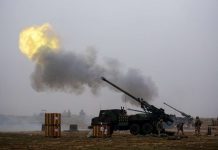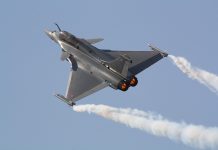
On February 2, the Ukrainian Air Force faced another major setback when a Su-27 fighter jet was downed by a Russian Su-30SM using an R-37M long-range missile. Reports from both Russian and Ukrainian sources indicate that the attack occurred from an extraordinary distance of approximately 130 km (81 miles).
The R-37M, a key weapon in the arsenal of the Russian Aerospace Forces, is designed to neutralize enemy aircraft before they can effectively engage in combat. In this instance, the missile executed its purpose with devastating accuracy.
This incident was not just about the destruction of an aircraft—it also marked the tragic loss of its pilot, 24-year-old Captain Ivan Bolotov. Unable to eject, he perished in the crash. His squadron, the 831st Tactical Aviation Brigade, confirmed his passing in an official statement shared on social media.
“With deep sorrow, we announce that Captain Ivan Bolotov, one of the Air Force’s most talented young pilots, was killed in action. A brave fighter and a true patriot, he defended Ukraine’s skies until his final moment,” the statement read.
The loss of yet another Su-27 exacerbates the already dire situation for Ukraine’s Air Force. According to data from Oryx, a platform tracking military losses, Ukraine has now lost 16 visually confirmed Su-27s. Prior to the war, the country operated around 30 of these aging yet powerful jets, though some non-operational units were restored and reintroduced into service following the Russian invasion.
As air combat over Ukraine grows increasingly intense, each aircraft and pilot lost represents both a significant blow to the nation’s defense capabilities and a profound personal tragedy for the families, comrades, and loved ones of the fallen. In the war-torn skies, no area remains truly safe.
The Engagement
The encounter began when a Russian Su-30SM, a twin-engine multirole fighter, detected the presence of a Ukrainian Su-27 in contested airspace. Using its N011M Bars radar, the Su-30SM tracked the target from a substantial distance, leveraging the system’s capability to lock onto enemy aircraft beyond visual range.
Russia’s integrated air defense network likely played a role in the engagement, providing early warning and additional targeting data. This enhanced situational awareness allowed the Russian pilot to position strategically for an optimal strike.
Once the Su-27 was identified as a target, the Russian pilot prepared to launch the R-37M missile. This air-to-air weapon, designed to engage high-speed and maneuverable targets, relies on initial guidance from the launch aircraft’s radar before activating its own seeker in the final phase of flight.
Capable of reaching over 300 km in ideal conditions, the R-37M was launched from well outside the effective range of most Ukrainian air-to-air missiles. After release, it rapidly accelerated to hypersonic speeds in its initial boost phase. Throughout its flight, the missile received mid-course updates from the Su-30SM, refining its trajectory based on real-time tracking data. As it neared the target, the R-37M’s onboard radar locked onto the Su-27, making final adjustments to ensure a precise hit.
Given the missile’s extreme velocity—exceeding Mach 6—the Ukrainian pilot likely had little time to react. The Su-27 may have attempted evasive maneuvers or deployed electronic countermeasures, but the missile’s speed and advanced targeting capabilities made escape nearly impossible. Within seconds, the missile reached its mark, either detonating in close proximity or striking the aircraft directly, causing catastrophic damage and sending the jet spiraling to the ground.
This incident underscores the significant technological advantage provided by Russia’s long-range air-to-air missiles. Such weapons enable Russian pilots to engage adversaries from distances where counterattacks are nearly impossible. The use of the R-37M highlights a shift in aerial warfare, where engagements are often decided by extended-range weaponry and sophisticated sensor networks rather than traditional dogfighting.
Comparing the Su-27 and Su-30SM in Air Combat
In a close-range aerial engagement between a Ukrainian Su-27 and a Russian Su-30SM, multiple factors influence the outcome. Both aircraft, though highly capable, have distinct strengths and weaknesses.
The Su-27, originally developed by the Soviet Union and now a key part of Ukraine’s Air Force, is renowned for its agility, particularly at high speeds and during close-quarters combat. Its large delta-wing design and powerful engines provide exceptional maneuverability, making it highly effective in tight turns and rapid directional changes—key attributes in a dogfight. Despite being an older platform, modernized avionics and radar systems have helped maintain its combat relevance.
Conversely, the Su-30SM, an advanced evolution of the Su-27 family, comes equipped with superior avionics and sensor technology. Its upgraded radar system enhances target detection, tracking, and overall situational awareness. Additionally, the aircraft features thrust vectoring nozzles, significantly improving maneuverability—especially at low speeds or in post-stall conditions—giving it a notable advantage in a close-range encounter.
However, technological superiority does not solely determine the outcome of an air battle. Pilot skill remains a decisive factor. An experienced Su-27 pilot could leverage the aircraft’s agility to gain a tactical edge, even against a more advanced opponent. Conversely, an inexperienced Su-30SM pilot could still be outmaneuvered by a seasoned adversary if they make tactical missteps.
Both jets carry a range of air-to-air weapons, including beyond-visual-range (BVR) missiles, but in a close combat scenario, the pilots’ ability to utilize their aircraft’s capabilities effectively becomes the key determinant of success. While the Su-30SM benefits from superior radar and missile guidance systems, in a high-intensity dogfight, the Su-27’s raw agility might allow it to evade attacks and outmaneuver its opponent. If the engagement devolves into a chaotic, close-quarters battle, the Su-27’s handling characteristics could potentially give it an advantage.
Conclusion
Although the Su-30SM possesses notable technological advantages, including advanced radar systems and thrust vectoring, victory in air combat is not guaranteed by technology alone. The Su-27, despite being an older platform, remains a formidable adversary due to its maneuverability and the critical role of pilot skill in determining the outcome of engagements. The result of any air battle depends on numerous factors, including tactics, experience, and the specific circumstances of the fight.





